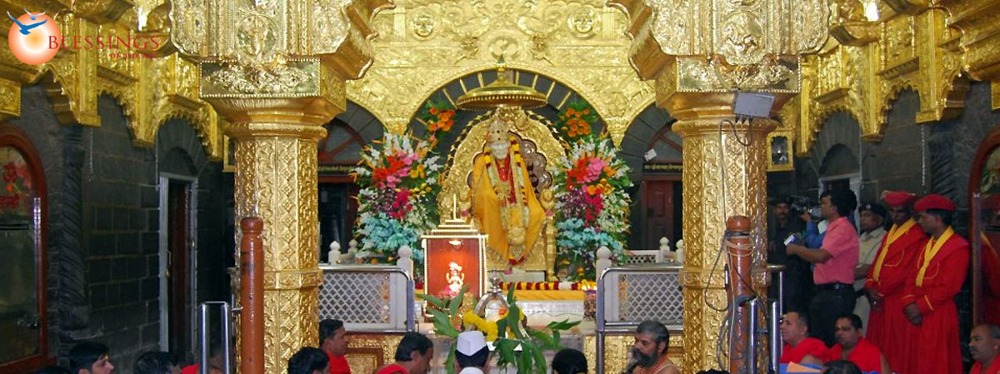
The holy town of Shirdi is visited by thousands of devotees and tourists every year for a Darshan of ShriSai Baba at the Samadhi Temple. Sai Baba's presence is seen all over this town. There are several places in Shirdi to visit which are connected with the Holy Saint Sai Baba in some way or the other.
It is the main attraction of Shirdi as the temple houses the last remains of Sai Baba. A rich man from Nagpur started the construction of the temple to place an idol of Lord Krishna; however the last remains of Sai Baba were to be placed here as he departed this life in 1918, since then the place holds immense reverence for Sai Baba's devotees from all across the world. The temple is the central point of the Shirdi pilgrimage and people stand in long queues to catch a glimpse of Sai Baba's mortal remains.
Just right of the Samadhi Mandir is the Dwarkamayee Masjid; it is the place where the Saint Sai Baba spent a major amount of his lifetime. At this Mosque, Baba used to light up lamps every evening. A huge stone is still preserved in this Masjid on which Sai Baba used to sit. The sacred 'Dhuni' or fire is still lit till this date and the astounding 'Udi' or ash from this fire is given to pilgrims and is considered immensely divine. The Masjid contains a life-size portrait of Sai Baba.
The Chavadi is a small house situated close to the Masjid. Sai Baba spent every alternate night over here. One can find here the 'Asan' or seat on which he used to sit, a wooden plank and a wheel chair owned by Sai Baba. His body was bathed here for the last time before his funeral.
Gurusthan is the place where Sai Baba was first spotted under a neem tree in Shirdi. A huge portrait of Sai Baba is placed here in front of which incense keeps burning day and night.
The Khandoba temple is situated at the Ahmednagar-Kopergaon road and is dedicated to Lord Shiva. It is among the oldest temples of Shirdi. It was at this temple that the priest called Baba with the name "Aao, Sai" hence he became well known as Sai Baba.
Sai Baba used to spend time here meditating and used to daily light a lamp in earthenware which is known as Nandadeep. He made a small garden here which still remains and is beautifully decorated.
The Museum is situated in the center of the Sansthan complex and contains rare black and white photographs of Sai Baba. Other articles like Baba's 'Kafni' (long robes) and his leather Padukas, gramophone records, smoking pipe, water tumblers, bathing stone and cooking utensils which were used by Sai Baba are on display. The museum remains open from 10 am to 6 pm.
ShriSai Baba used to sleep in Chawri every alternate night. This visit at Chawri was prefaced by a 'palki' procession and Sai Baba was accompanied from Dwarakamai to Chawri. Even nowadays this palki procession is carried out with the same enthusiasm and adoration. The procession starts from Samadhi Temple to Dwarkamai Masjid from here it goes to Chawri and returns to Samadhi Temple. ShejAarti is presented to ShriSai Baba after the procession.
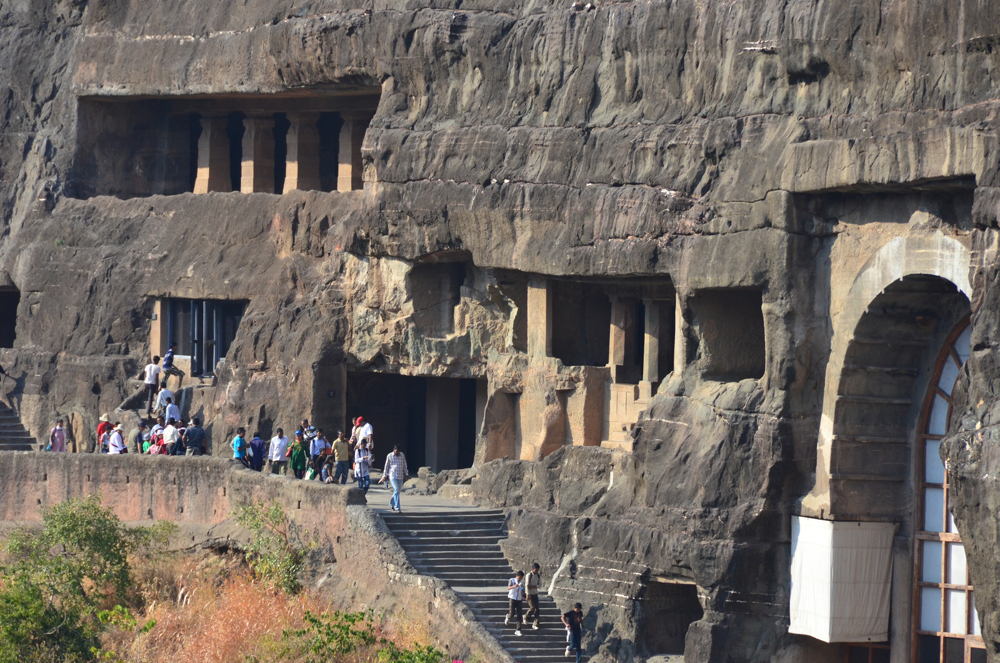
ShaniSinghnapur is a village about 73 km from Shirdi. Devotees come here to receive the blessings of ShriShani Dev. One unique thing about this village is that there are no doors or locks in any of the houses and it is believed that it is because of Lord Shani's blessings that there is no crime in the village.
Nashik is around 86 km from Shirdi and is a holy place that stirs up a personality of its own. It is rich in mythological association with great cultural and traditional significance. Several temples and religious sites can be explored here fulfilling your spiritual journey.
These caves are to be found near the city of Aurangabad in Maharashtra and are well-known for the cave shrines that are carved out of rock by hand. These caves are listed in the world heritage sites. There are 29 caves at Ajanta and 34 caves at Ellora, all pure specimens of Indian architectural brilliance.

Although planning a trip alone isn't very interesting, it can certainly be more absorbing. It takes a lot of efforts to identify the right tourist destination that would give you all that you expect on a holiday. Once you have the destination decided, you need to further your research to find out the important tourist places in the destination. Then comes the travel plan and arrangements for accommodation. If your plan is to visit Delhi during your holidays, here are some suggestions that would help you with your plan. Given below are 7 important places to visit in Delhi which you are not supposed to miss during your stay.
Red Fort symbolizes the era of Mughal rule in India. The Fort, built in 1638, is a magnificent monument that captivates your attention and exhibits the show of architectural splendor of Mughals. The 33m high walls of Red Fort were built with a view to prevent invaders. Sound and light show is conducted here in the evenings. The one-hour long show recreates historical events associated with Red Fort. The Fort is closed for visits on Mondays
Built in the year 1570, Humayun's Tomb is a monument built by Queen Haji Begum, widow of Humayun. The monument displays the inspiration of Persian architecture. The world famous TajMahal bears resemblance to this monument constructed during early Mughal rule in India. It is open on all days for visits. The best time to view Humayun's Tomb would be in the late afternoon.
India, QutabMinar, is said to be constructed to commemorate the victory and the beginning of Mughal era in India. The 73-meter tall tower was built by Qutab-ud-din Aibak after the last Hindu Kingdom was defeated. However, some say that it was built to serve as a minaret to call those faithful to prayer. QutabMinar has five storeys and every storey is marked by a projected balcony. While red sandstone was used in the construction of first three storeys, marble and sandstone were used to construct the last two storeys. India's first ever mosque, Quwwat-ul-Islam is at the foot of QutabMinar.
Bahai Temple is famously known as Lotus Temple owing to its resemblance to lotus flower. Lotus symbolizes four religions namely Hinduism, Islam, Buddhism and Jainism. Out of the seven major Bahai temples constructed around the world, the one in Delhi was constructed last. The structure was completed in the year 1986 and pure white marble was used in the construction. The place is serene and is open for prayers and meditation by people who follow any religion. The nine pools of water around the petals is a sight to watch at dusk.
view of BadaGumbad Masjid at LodhiGarde
If you want to have a quiet day to escape the crowd and the busy life, this is where you need to be in Delhi. Lodi Gardens was built in 1936 by British around the tombs of the rulers of 15th and 16th centuries. The 90-acre Garden is an excellent place to relax, walk, jog and enjoy the beauty of nature. The National Bonsai Park situated in the Gardens is yet another attraction.
Whatever faith you may be following, you could take your time to visit SwaminarayanAkshardham Temple, the world's largest Hindu Temple. The 42 meter tall construction was completed in the year 2005. Apart from using concrete for the foundation, the entire construction was made using granites and marbles from all parts of the world. The structure stands proof of architectural excellence. In the 12 acres of land, you will find the temple, museum, several parks and a huge cultural center that throws light on the traditions and customs followed in India. You can go boating in the water canals here.
India Gate was constructed in the year 1931 as a war memorial for over 70,000 soldiers killed during First World War and Afghan War. The names of the soldiers are inscribed in the walls of India Gate. It was earlier known as "All India War Memorial". Situated on Rajpath, India Gate looks stunning in the evening lights. The lawn throughout Rajpath's stretch is frequented by people as the atmosphere is pleasant.
Note** Delhi has a lot to offer but the above-mentioned places are worth special mention. The first three in the list, Red Fort, Humayun's Tomb and QutabMinar are declared world heritage sites. Bahai Temple is unique being one among the seven major Bahai temples in the world. You will love Lodi Gardens for the serene atmosphere and lush greens while SwaminarayanAkshardham is not only a visual delight but also a clear example of architectural excellence and splendor of Modern India. India Gate not only relives memory but offers a pleasant atmosphere. Do not miss out on the special tourist places in Delhi during your visit. But if you live in Delhi and are looking for places to enjoy weekend getaways; you need not worry as there are many picnic spots and hill stations near Delhi which are perfect for that.
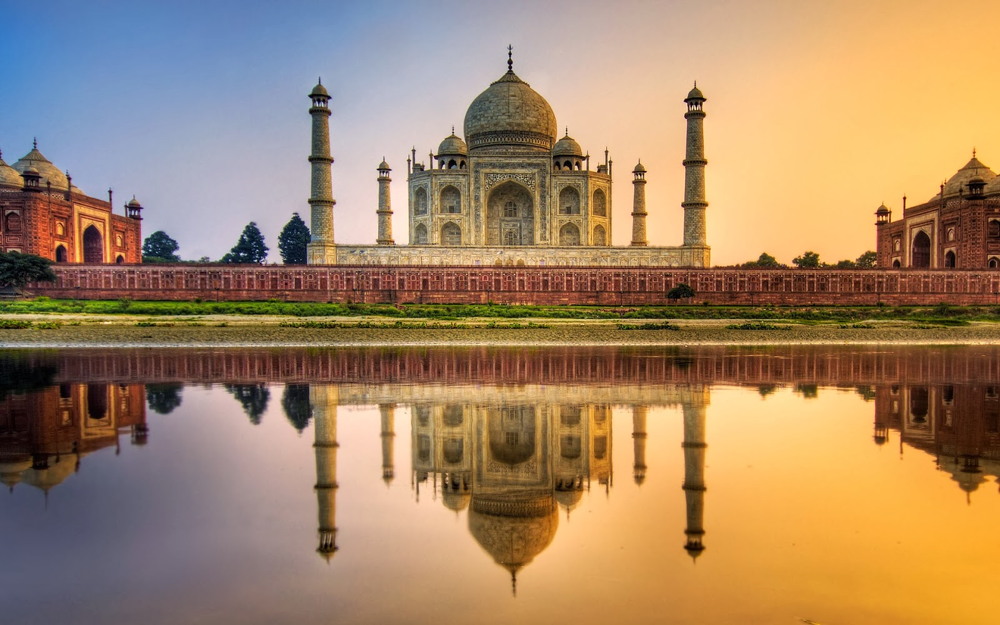
Whatever type of tour one may opt for, be it a tour for entertainment or pilgrimage, there is an element of education in it. Man learns a lot while traveling and it was travel that has brought the early man this far. Every place has a message and every tour has an element of entertainment, education and of course fun. However, there are certain locations that stand apart for the sheer excellence they have to offer in terms of natural beauty or man made wonders. Agra in Uttar Pradesh is one such place and if it is your choice destination for this year's vacation, take some time to go through the places to visit in Agra that you are not supposed to miss on your tour to Agra.
You cannot think of Agra without thinking of TajMahal. Or, you might not have thought of Agra were it not for the monument of love. TajMahal, the white marble beauty was constructed by Shah Jahan in memory of his beloved wife, MumtazMahal. The monument stands proof for the brilliance of Mughal architecture. Named as one of the wonders of the world, TajMahal stands the test of time. It has been declared as World Heritage Site in the year 1983. It is a feast to your eyes and senses to watch the unmatched beauty on the night of full moon day.
You would regret if you miss Agra Fort during your visit to Agra. The 16th century monument is yet another proof of the architectural brilliance of Mughals. This is situated near the gardens of the world famous TajMahal. Called the Red Fort of Agra, you will be awe inspired by the powerful fortress. The fortress comprises many palaces namely, Jahangir Palace, KhasMahal and so on. There are audience halls and two mosques. The entire fortress is a symbol of Mughal's grandeur. It was in Agra Fort Shah Jahan was held prisoner by Aurangazeb, his son. Shah Jahan, the emperor, spent his last days here viewing the monument of love he had built for his wife.
Built by Akbar, the Mughal emperor in 1570, the city was a tribute to Sufi Saint. Fatehpur Sikri is a perfect blend of Indian, Islamic and Persian architecture and it was built using red sandstone. For around 10 years, the city remained the capital of Mughal Empire. The city has a 6-kilometer long wall on three sides and there are towers and gates. It houses some of the city's important buildings namely BulandDarwaza, Birbal's House, PanchMahal and Jama Masjid. The entire city along with all the important constructions including royal palaces, Jama Masjid and courts were declared as World Heritage Site in the year 1986.
India's first tomb to be made completely out of marble, Itmad-Ud-Daulah signals the beginning of new era in Mughal architecture. Until then, it was buildings of red sandstone. It was constructed during Jahangir's period. The 21-meter high tomb was constructed in memory of MirzaGhiyas, who was the father-in-law of Jahangir. He was bestowed with the title Itmad-Ud-Daula, which means pillar of the state. Influenced by Islamic architectural style, the monument's towers display Persian touch. The wall paintings inside are sheer beauty to view.
Visiting Wildlife SOS could be said to be the duty of humankind to help balancing the world and make it a better place for all creatures. Wildlife SOS is a voluntary organization that works for the welfare of animals in India. The place is a revelation that lets you aware of the various projects of the organization to preserve wild life. This will definitely be an inspiring experience. Life has a lot in store for every one. Unfortunately, the deprived are left to fend for themselves. We could plan our pleasure trips in such a way that it helps us gain knowledge on subjects we never had the time to know about and make our trips useful while elevating ourselves to a higher plane.
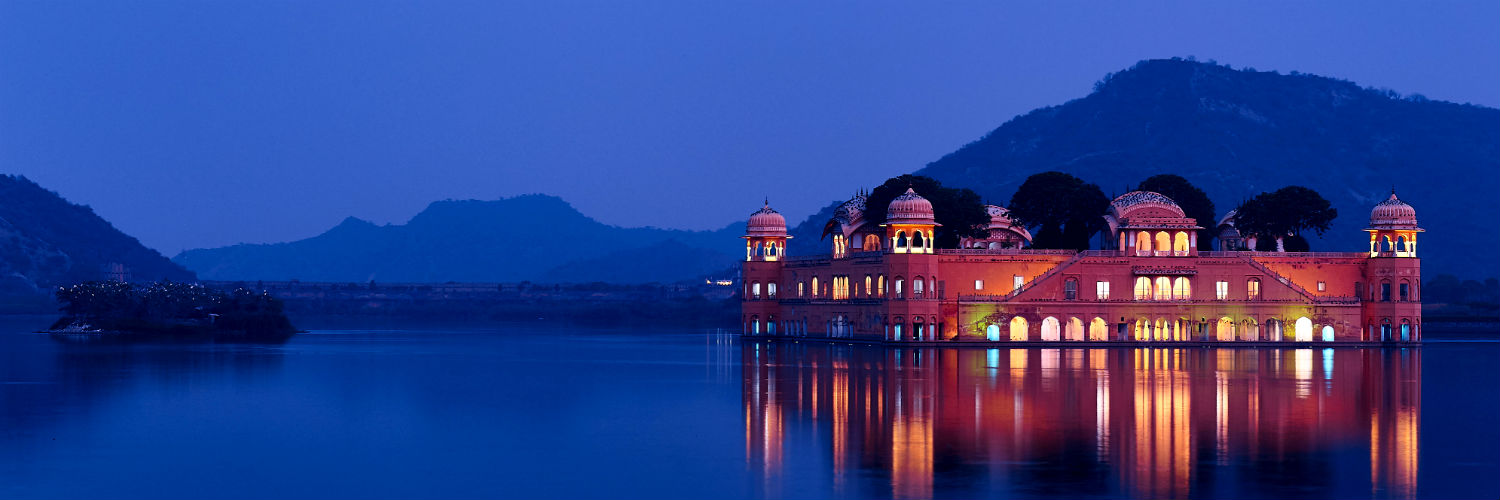
If you love palaces and crave to have an insight on the lifestyle of the rulers of the bygone era, Jaipur is the city for you. If you are passionate about the strong forts and marvelous architecture that flaunt the expertise of the artisans of the past, Jaipur is where you need to be on your vacation. If you long to experience the flamboyant lifestyle of the past rulers even if it is only for a few days, Jaipur's palaces-turned-heritage hotels are where you need to stay for a lifetime experience. If you fancy elephant rides, you need to be in Jaipur to have a royal ride on the elephants. You can customize the rides the way you need, take elephant rides on jungles, through villages, in Biological Park and many more. If these were not enough to decide in favor of Jaipur, go ahead to have a look at the top list of attractions in Jaipur and you cannot resist any more.
To experience the originality, to experience the traditional touch of the glorious past, your stop should be at old city, famously known as the Pink City, which is famous for magnificent palaces. The founder was Sawai Jai Singh II. To offer cordial welcome to Prince of Wales in 1876, the entire city was painted in pink color, which resembles hospitality. You cannot help marvel the architectural brain as the construction of the city was planned on providing excellent ventilation through out. You will love the exclusive artwork in the jewellery. You need to commence your Jaipur tour from Pink City, considered the first planned Indian city.
Once you are in Pink City, you will naturally be inclined to visiting City Palace, which is situated in Pink City. It was constructed by Sawai Jai Singh II between 1729 and 1732 AD. The palace complex comprises of Chandra Mahal and Mubarak Mahal. Now, Chandra Mahal has been converted into museum that houses exclusive handcrafted products and other products that depict the cultural heritage of the kingdom. Not only will you enjoy the architecture, you will be awe struck by the glorious view of Pink City from here.
A stunning presentation of the rich architectural expertise of the past, Hawamahal is a not-to-miss tourist places in Jaipur. The Mahal was constructed by Maharaja SawaiPratap Singh in 1799. True to the name it earned as the 'Palace of the Winds', HawaMahal has 953 windows to provide ventilation. The five-storey building does not have steps to reach upper floors. Slopes connect the storeys and it is said that the Mahal was constructed to enable the Royal women of Rajput family to view the happenings in the city. You would want to visit the archeological museum in Hawamahal during your visit.
Also known as Amer Fort, it is located in Amer, which is around 11 kilometers from Jaipur. It was constructed by Raja Mansingh in the year 1592. It was later expanded by Raja Jai Singh I. The red sandstone and marble stone construction reflect a blend of Hindu-Muslim architecture. The main entrance faces east and there are three more entrances. There are four courtyards in Amber Palace. One of the courtyards has the Public Audience Hall, called the Diwan-i-AAm. The place provides you an opportunity to ride on elephant. Though it is only a ten-minute walk to the fort, which is uphill, you will want to try it on an elephant.
If you have any doubts about having to spend your time at an observatory on your tour, reconsider it. Jantar Mantar is not just like any other average observatory; it is ranked amongst the largest observatories of the world. Built during the period of Maharaja Jai Singh II, the astronomical observatory has the largest sundial of the world. Maharaja Jai Singh II had avid interest in various subjects including architecture, astronomy, philosophy and astronomy. His keen interest in astronomy led him to construct the country's largest observatory. The geometric devices available here are used in measuring time, observing constellations and orbits around the biggest star. The astrological instruments attract astronomers and architects from all parts of the world. Whatever your level of interest in space, you will be inspired by Jantar Mantar Observatory.
Being in Jaipur, you would not want to miss elephant safari. If you are keen to engage the adventurous spirit in you, the hills behind Amer fort is the right place. This is where Dera Amer is situated and it is the foothills of Aravali Range. You will enjoy the elephant safari in the serene atmosphere. The ride will take you through fields, fortress and to the camp in the middle of Aravali forests. The picturesque landscape and the stunning beauty of the forest will elevate your spirits. If you love to experience your adrenaline rush, you need to opt for night safari. Whichever time you choose, you will be provided excellent meals that would keep your taste buds engaged.
Note** Jaipur is not just a tourist spot. It is a destination to learn, enjoy, wonder, experience, ponder and get adventurous. There are a lot more places to visit in Jaipur that you need to visit but if you are short of time, ensure that you do not miss the list given here. A perfect way to spend your vacation and you will definitely want to revisit. Apart from Jaipur, there are many more popular destinations in Rajasthan; kindly visit: tourist spots in Rajasthan to learn more about them.
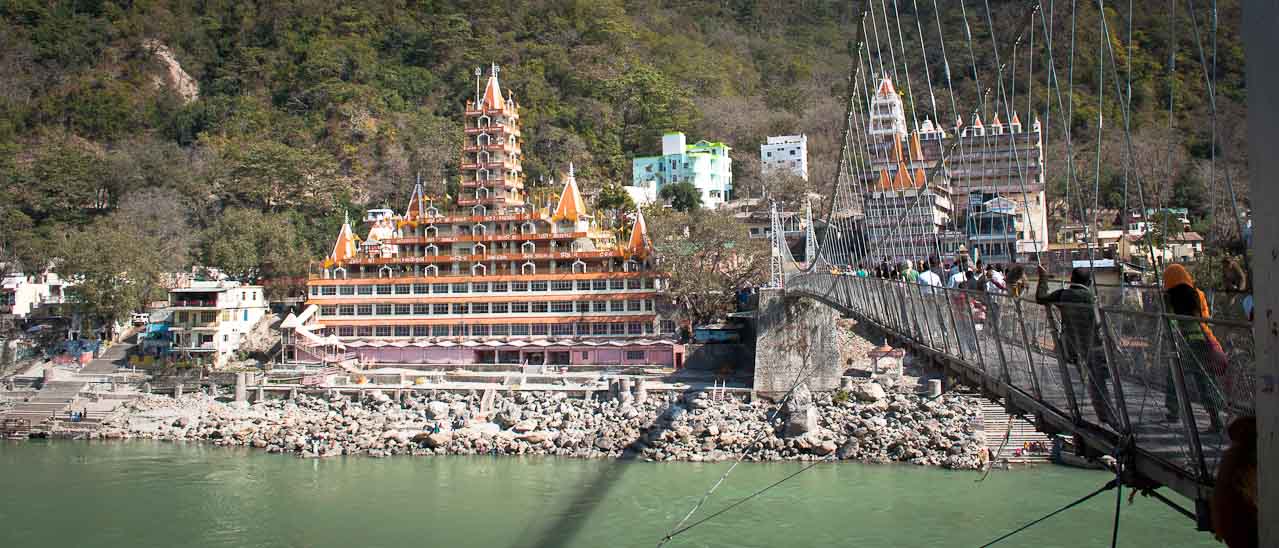
Located near the foot of the Himalayas in the Indian state of Uttrakhand, Rishikesh is the7th largest city in India. It is also called as the "Gateway to the Garhawl Himalayas". The town is a famous tourist spot and also a major pilgrimage spot for the Hindus. The River Ganges flows through the town of Rishikesh and it is famous for its various shrines and yoga ashrams. Rishikesh also is among the few places in India that offers a multitude of adventure sports to its visitors. With the city of Haridwar only a few miles south from rishikesh, the place is also considered as a 'holy city' and is vegetarian.
Note** Here is a list of top 10 places to visit in Rishikesh:
Located at a short distance of just around 20 kilometres by road, Haridwar is one of the most important pilgrim spots in India. The name of the town itself means gateway to god in Sanskrit. Hardwar has been a typical place to start a pilgrim's journey in order to reach Mount Kailash, the eternal abode of Lord Shiva and Badrinath which has a temple of Lord Vishnu and is one among the 'char dhams' pilgrimage of the Hindus . In ancient times, the town was also referred to as Gangadwara, the place where the Ganges descends to the plains.
Built in 1939, Laxman or LakshamanaJhula is a suspension bridge in Rishikesh With a length of 450 feet and at a height of around 70 feet from the river. According to Hindu mythology, this bridge is built in the same place, where Lakshamana once crossed the river Ganges on a jute rope, thus making this another important pilgrim attraction.
Situated at a height of 1675 meters, on a hill above Swarg Ashram the Neelkanth Mahadev Temple is one of the most important shrines dedicated to Lord Shiva in the Republic of India. In Hindu mythology, the temple stands at the exact spot where lord Shiva drank the Venom 'halahala' that originated after the churning of the ocean by the Devas and Asuras in order to obtain the Amrita or the elixir of life.
In February 1968 the Beatles travelled to the Indian town of rishikesh to attend a session of transcendental Meditation at the ashram of Maharishi Mahesh Yogi. It was this visit that changed the world's outlook of Indian spirituality. This was considered to be the Beatles' most productive time, they wrote various songs during this visit most of which gained huge media attention and commercial success.
Located at a distance of 19 kilometres from Rishikesh, The town of Shivpuri is situated on the banks of the river Ganges and is famous for its Temple dedicated to Lord Shiva.
On the left bank of the river Ganges, is located one of the oldest Yoga ashrams in India. The Swarg ashram covers the whole area between the ram and the Laxmanjhula and was built in the memory of Saint Swami Vishudhanand. It's a perfect place for people who seek solitude in this holy city. You can sit and meditate for hours near the private river banks which are totally devoid of any rituals found at the rest of the banks or just sit watching the sun rise from the Shivaliks, setting fire to the cold, glistening waters of Ganga.
Rishikesh is one place which does not only provide the visitors with a dose of spirituality but also a taste of the thrill of adventure sports. The best example of such an offering is the jumpin heights centre, where you can experience the adventure of bungee jumping, fox flying and the Giant swing right over the river
Founded in 1942 by Pujya Swami ShukdevanandjiMaharaj, Parmarth Niketan is an ashram located in Rishikesh. It's the largest ashram in rishikesh with over a thousand rooms. Parmarth Niketan provides its thousands of pilgrims - who come from all corners of the Earth - with a clean, pure and sacred atmosphere as well as abundant, beautiful gardens.
Located at a distance of 20 kilometres from rishikesh, Narendranagar lies in the TehriGarhawl district of Uttrakhand and is situated at a height of 1,326 meters above sea level. The town came into existence 1919, when the TehriGarhawl ruler Maharaja Narendra shah moved his capital to the picturesque location of Odathali or Narendranagar.
Kaudiyala is considered to be one of the most visited view-points in Rishikesh. Located at around 36 kilometres from rishikesh towards Devprayag and 380 meters above sea level, Kaudiyala is famous for offering its visitors the adventure sport of white water rafting and is one of the premier locations in the country for this sport. Dense hill forests surround the region and the place is also a habitat for many wild species of flora and fauna.
Note** The town is not only rich with the Hindu cultural heritage and its various pilgrim spots, but is also situated at a picturesque location which makes its visitors feel close to nature. Making a list of just 10 places is a tough task but in case any of you think we have missed a 'must visit'.
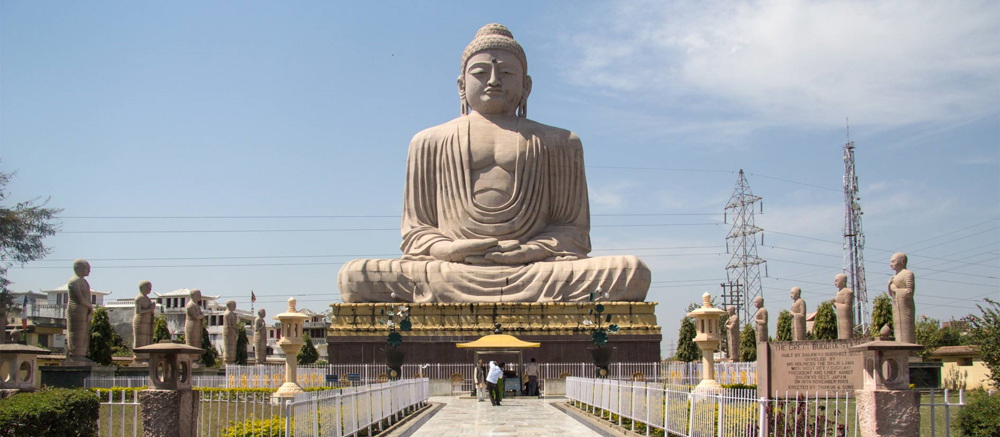
If you are looking to travel to a place that taps the beliefs you hold dear, you may visit places that boast of ancient temples and famous spots that are associated with your beliefs. Gaya is one such place that is close to the heart of those who follow Hinduism, Jainism and Buddhism. If you are not the category that limits yourself to a particular religion but seek to admire the wonders of the world of the ancestors, Gaya could still be a great choice as the land has some of the best constructions that highlight the architectural brilliance of an era in the past.
Note** Here are top 10 places in Gaya, the city in Bihar, which is famously associated with Gautama Buddha, a prince who turned down his right to throne to rule the hearts of millions who were sick, homeless and who believed in him as their savior. He was a precise example that proved that power does not lie in acquiring and ruling lands but true power is all about remaining detached from worldly pleasures and conquer the hearts and not the lands. On the banks of Lilanjan River, Bodh Gaya, famously referred to as Gaya, welcomes you to its attractions. Many across the world who follow Hinduism and Buddhism frequent the land, as it is considered a place of importance going by the epic Ramayana and it is where Buddha made the Fire sermon. For nature lovers, the place holds attraction as it is located in a stunning setting amidst hills thus presenting a picturesque landscape that is both serene and stimulating. The order of places given below is not suggestive of ranks, as it depends purely on your beliefs and interests. Here we go.
Mahabodhi Temple stands tall and proud portraying the architectural splendor of the past. Standing on a 48 square feet tall basement, the structure resembles a pyramid but for its cylindrical top. Belonging to the 7th century, the temple was reconstructed in 1880 and has since had many facelifts. Though the main deity is Lord Buddha, the temple promotes tolerance towards other religions. The Chatras built at the top of Mahabodhi temple preach sovereignty of religion. Apart from followers of Buddhism, Hindu devotees too consider this site important to them, as they consider Buddha as the ninth incarnation of god Vishnu. A 9th century Shivalingam is also found in the temple.
Located on Falgu River banks, Vishnupad temple is considered to be constructed on Lord Vishnu's footprints and hence the name. This ancient temple was reconstructed in the year 1787 by Indore's queen Rani AhilyaBai. The footprint is 40 cms in length. The huge temple complex displays images of various gods and goddesses. Temple for Lord Nrisimha is found in the courtyard of Vishnupad temple. A special feature of this temple is that its eastern side is dedicated to god Shiva.
Referred to as Mahakala caves, Dungeshwari Cave temples gain spiritual importance as Buddha spent many years here before he headed towards Gaya and enlightenment. If you are looking to see something interesting inside the caves, may be you will end up being disappointed. On the contrary, if you are looking to see inside you in a soul-searching attempt, this could be the right place. It is a great destination to meditate in a serene atmosphere.
An excellent spot that reaches out to the hearts of those who love anything ancient, Barabar Caves date back to Mauryan era that span between 322 BC and 185 BC. They proudly hold the top rank of being the most ancient surviving rock-cut caves in the land. Four caves comprise Barabar caves out of which the most fascinating caves are Lomas Rishi caves. Its construction shares similarity to wooden huts, which were home to Buddhist monks. Lomas Rishi caves are the oldest of all rock-cut caves as well and they influenced many to come in the following centuries. The Hindu sculptures and Jain sculptures found in the caves date back to 273 BC to 232 BC. The inscriptions on the walls depict the history and growth of Buddhism.
The special feature of these caves is that their cuttings are so wonderfully sharp that they draw parallels to the laser cuttings of the present times. In short, Barabar caves not just delight but stun architecture minds.
Bodhi Tree is considered sacred by followers of Buddhism as Buddha attained spiritual enlightenment here. The tree, which is situated on the southern side of Mahabodhi temple is not the where Buddha's enlightenment occurred but it is the fifth generation of the original tree. Going by myth, Emperor Ashoka's wife uprooted the original tree, as she was jealous about the devotion of her husband to Buddha. It is believed that after the tree was fell down on his wife's order, he poured milk on the roots of the tree after which it revived. The tree was destroyed again in 600 AD and this time it was by King Sesaka. However, a sapling from the original tree was planted in 620 AD by King Purnavarma.
Chinese temple is located near Mahabodhi temple. The temple is a pure influence of Chinese architecture. It was built by the government of China and Buddhist monks of China in the year 1945. 200-year-old Buddha statue found in the temple is said to be from China. The temple also houses three golden statues of Buddha. Chinese temple underwent renovation in the year 1997. The travelogues written by Chinese scholars who visited India during various periods give an insight into the culture of the past.
Established in the year 1956, Bodhgaya Archaeological Museum is home to several relics unearthed from this part of the world. Some of the rare collections include sculptures belonging to 1st century BC, antiques and images of Hindu deities and Buddha made of various metals including gold, silver and bronze.
Muchalinda Lake is considered a sacred place for followers of Buddhism. It is said that while Buddha was into the sixth week of meditation by the side of Muchalinda Lake, a severe storm struck. Muchalinda, the snake king protected Buddha who was deep in meditation. The temple found here houses the sculpture of Buddha and the snake in the act of protecting the god. The lake is a feast to nature lovers, as it is surrounded by lush green environment.
The only Thai temple to be located in India was built in the year 1956 by Thailand Monarch following the request from the then Prime Minister of India Jawaharlal Nehru. The temple is a fine specimen of Thai architecture. The amazing construction with a sloping roof that is curved is a visual delight to those with architectural eye. The golden tiles over the roof look brilliant in sunlight. The serene atmosphere inside the temple and outside the monastery takes your mind to a different world. Statue of Buddha inside the temple is made of bronze. A statue of Buddha measuring 25 meter in height enhances the magic of the beautiful garden near the temple and the monastery.
Yet another monastery in Gaya, Royal Bhutan Monastery appeals to the followers of Buddhism with its wonderful depictions of the life of Buddha. Bhutan kind constructed this monastery, which ranks amongst the majestic monasteries in the land. The influence of conventional architecture strikes you the moment you set your eyes on the monastery. It houses a beautiful temple in which you can find 7 feet tall Buddha statue. The serene atmosphere makes it a wonderful place to meditate.
Note** Gaya is an amazing place to be on a holiday. Beliefs apart, the place is rich in natural beauty and architectural splendor. The land may be influenced by a couple of religions but the message of tolerance towards other religions is loud and clear. Your visit to the land with a rich cultural past will leave you with memories to cherish for many years to come.
As you are well aware, the above list is not the ultimate. I would be glad if you could send in your suggestions about places that demand their rightful place in the list of attractions in Gaya.
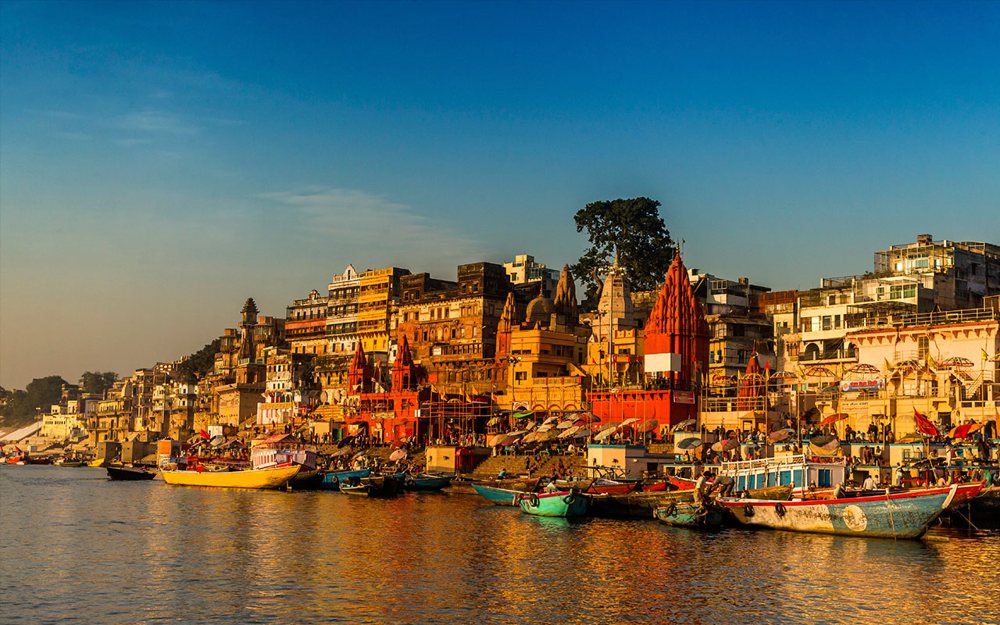
Also known as the Golden Temple, it is dedicated to Lord shiva, the presiding deity of the city. Varanasi is Said to be the point at which the first jyotirlinga, the fiery pillar of light by which shiva manifested has supremacy over others gods, broke through the Earth's crust and flared towards the heavens. More than the Gaths and even the Ganga, the Shivalinga installed in the temple remains the devotional focus of Varanasi.
Banaras Hindu University (B.H.U) founded by PanditMadan Mohan Malviya in 1917A.D is the largest residential University in India. At the entrance, there is the grand statue of its founder and the Vishwanath temple in its centre. The huge temple was built in 1966, under patronage of the Birlas. It has a 677 meter high rising white top and its well carved architecture attracts pilgrims.
In the cool and calm surroundings of B.H.U is the Bharat Kala Bhavan which has established in 1920A.D and has a vast collection of paintings, Hindu and Buddhist sculptures and other materials of archeological studies. In the main hall of the Bhawan, there is a figure of a man standing on one leg and one hand on his hip and lifting a mass of stone above his head, with one hand. The figure is said to be of Lord Krishna lifting Govardana. In the halls of the Bharat Kala Bhawan, there are many rare images that testify to the existence of Krishna cult in Kashi in 15th and 16th century Gupta period. It has the miniature paintings from the courts of Mughals and the Hindu Princes of Punjab Hills.
Note** Visit : Monday to Saturday . Opens from 1030 to 1600.
The spectacular 4 km sweep of the Ghats is unique sight, best viewed at dawn, in that "soft first light" when the river and Ghats have a timeless appeal. Life is almost panoramic detail unfolds here from dawn to dusk as a steady stream of devotees-swelling to thousands on auspicious days -perform rituals by the Ganga. The Ghats are best approached by Dashashwamedhaghat, where boats are available on hire.
godessdurga is considered as the goddess of Strength and Power. This temple was built in the 18th century with red stone work. A fine example of Nagara art. This temple falls on the main route from Railway Station to BHU, just before TulsiManas temple and Sankatmochan temple.
Constructed by family of Varanasi, this modern temple is dedicated to Lord Rama. It is situated at the place Where Tulisdas, the great medieval seer, lived and wrote the epic "ShriRamcharitmanas", which narrates the life of Lord Rama, the hero of the Ramayana. Verses from Tulidas's epic are inscribed on the walls. SANKATMOCHAN TEMPLE Lord Hanuman temple, who is known to be the 'Sankatmochak' is just 300 meters from TulsiManas Temple. It is an ancient temple considered as built by GoswamiTulsidas himself.
Situated in the premises of Banaras Hindu University, a modern place of worship planned by PanditMalviya and built by the Birlas. Open to all, irrespective of caste or creed.
Kashi Vidyapeeth was set up in 1920 by Babu Shiv Prasad Gupta to provide alternate education arrangement discarding that of the British. It soon became a centre of natoinal education with Hindi as the medium of instruction. AcharyaNarendradev, BabuSampurnanand, BabuSriprakash& many more Luminaries of the time have been associated with this institute.
Note** MUSUEMS & ARTS GALLERIES Archaeological musuemSarnath open 09:30 am.- 5 pm. Friday clossed. Ramnager fort musuem, open 10 am.-5 pm. Clossed on Friday. Bharat Kala Bhawan B.H.U. open 10:30 am.- 4 pm. Clossed on Sundays & university holidays. Archaeological musuem, Sampurnanand Sanskrit University open 10 am. - 5 pm. Clossed on Sunday & university holidays.
This Temple was inaugurated by Mahatma Gandhi in 1936 and houses one perfect relief Map of India carved out of marble. The Temple was gifted by the nationalists Babu Shiv Prasad Gupta (Barat Ratana ) and shriDurga Prasad Khatri, leading numismatists and antiquarians. It is inside the premises of KashiVidyapeeth.
AshokaPiller-Sarnath It is at Saranath, 10km north of Varanasi. Sarnath, the place where Buddha gave his first sermon is a popular Buddhist pilgrimage centre. The Ashoka pillar stands in front of the main stupa where Ashoka sat and meditated. The Sarnath Archaeological Museum at AshokaMarg, houses a copy of Ashoka's lion pillar and some sculptures.
The residential place of KashiNaresh (Former Maharaja of Varanasi) across the Ganges at Ramnagar houses a museum with the exhibits of palanquins, costumes, swords, sabres, etc. Dussehra celebration of Ramnagar is an interesting event to witness.14 km. from Varanasi. The fort at Ramnagar houses a museum displaying the Royal collection which includes vintage cars, Royal palkies, an armoury of swords and old guns, ivory work and antique clock. The Durga Temple and Chhinnamastika Temple are also located at Ramnagar. Ramnagar Fort which was built in 1750A.D by the Maharaja of Banaras, is on the right bank of River Ganga. Built of red stones, it provides strength and stability to the city. Visit : Daily from 0900 t0 1200 and 1400 - 1500. It is the residential palace of the former Maharaja of Varanasi. The palace is an astronomical and astrological wonder. Inside the giant walls of the palace, there is a big clock. Besides showing year, month, week and day, it baffles the onlooker with astronomy of the sun, moon and constellation of stars. This wonder clock or DharamGhari was made by the court astronomer of Banaras in 1852A.D. The palace has a temple dedicated to VedVyas and a museum set up by the last Maharaja of Banaras, VibhutiNarain Singh. The museum has a collection of brocade costumes, palanquins, weapons and has expensive coaches made of ivory. The palace is decorated majestically and it vibrates with colour and life, during Dussehra festival. The celebrations comes to an end on Vijayadashmi, when the huge effigies of demon king Ravana and his kinsmen are sent up in flames, signifying the victory of good over evil.
An amalgmation of Hindu-Muslim religious sentiments, this mosque is also known as " BeniMadhavkaDarera". Curiously, the entire lower portion of the mosque is retained as a Hindu temple.
The only institute of its kind in the world, ,imprating education in the Tibetan language, it was Est. by the Dalai Lama in 1971. Presently located at Sarnath.The institute has a rare collection of Buddhist texts, Tibetan manuscripts and other journals.
Jantar Mantar is an observatory, built by Jai Singh, the Maharaja of Jaipur in the year 1737. Jai Singh was a great admirer of science and technology and he was particularly passionate about astronomy. Before the commencement of construction (of observatories) he sent scholars abroad to study the foreign observatories. The emissaries returned with many manuals on astronomy. The Jantar Mantar at Varanasi was built in line with Delhi, Mathura, Ujjain and Jaipur observatories.
The Jantar Mantar was built to measure the local time, the Sun's declination, altitude, the declination of stars, planets and to determine eclipses The Jantar Mantar at Varanasi has several masonry instruments to record the motion, speed and properties starts and planets and study astronomy that are accurate and can still be used efficiently today. The Jantar Mantar incorporates multiple structures of unique form, each with a specialized function for astronomical measurement. These structures with their striking combinations of geometric forms have captivated the attention of architects, artists, and art historians. Originally, there were many yantras (instruments). Some of the important ones are the KrantivrittaYantra, DiganshaYantra, SamratYantra, PrakashYantra, Ram Yantra, DishaYantra and DhruvaYantra
Jain temple The Famous Jain Saint Shvetambar temple is there juust on the way from Railway Station to BHU, before Bhelupurstreet.
Aghor is the pinnacle of spirituality. With the advent of the great saint of 20th century, ParampujyaAghoreshwarBhagwanRamji, aghor tradition was integrated in the society. He utilized his spiritual prowess in public welfare and in the eradication of prevailing evils in the society. He established Sri SarveshwariSamooh on September 21, 1961 for the service of suffering humanity. Public service, establishment of global peace and maintaining harmony among religions are the objectives of this Samooh.
ParampujyaAghoreshwarBhagwanRamji also established "AwadhootBhagwan Ram KustaSewa Ashram" for treating leprosy patients. This institution has been included and certified by the Limca Book of Records and Guinness Book of world records as it has fully cured more leprosy patients than any other hospital.
After AghoreshwarBhagwanRamji left his mortal body on 29th November 1992, all the programmes of the organization are conducted under the guidance of its present president Parampujya Baba GurupadSambhavaRamji who established the MahavibhutiSthal (Samadhi) of AghoreshwarBhagwanRamji on the bank of Ganga. This establishment is an unprecedented example of architecture and sculpture. On the bank of Ganga itself, a worth-seeing "AghoreshwarBhagwan Ram Ghat" has been built by the Tourism Department. Recently an old age home has also been newly constructed.
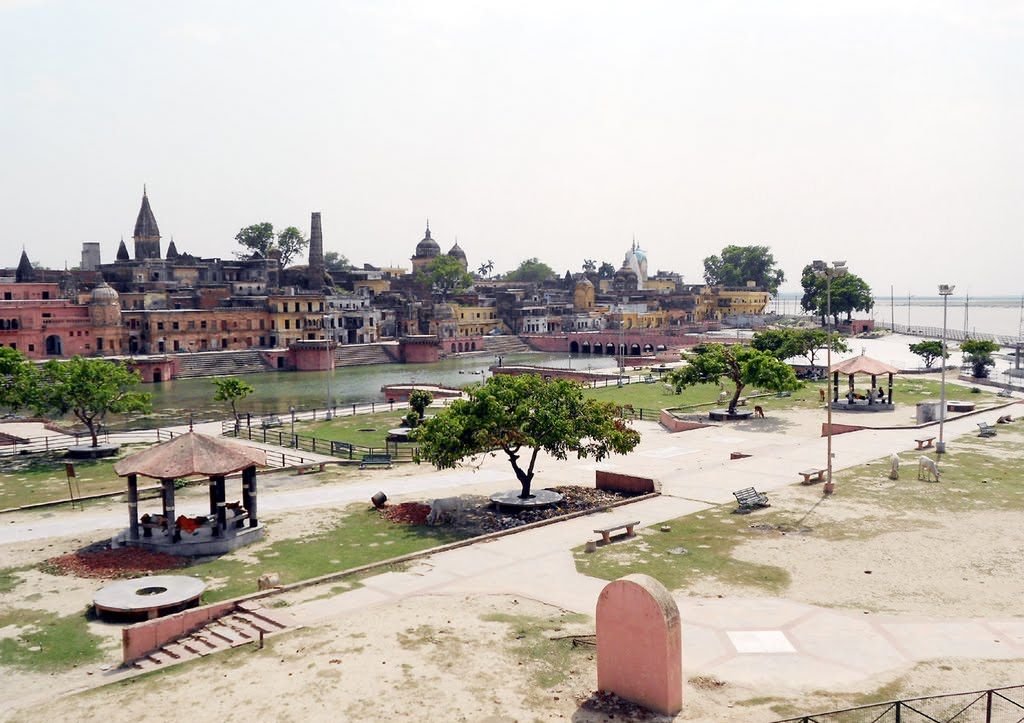
The ancient city of Ayodhya is known by most to be the setting of the ancient Hindu epic Ramayana and is known to be the birthplace of the God king Ram. The city is located at the banks of the Sarayu River and was the capital of the ancient kingdom of Kosala. The city was known to be founded by the Hindu deity Manu and is believed to be 9000 years old. It is one of the most frequented pilgrim spots and is famous for its various temples which are visited by people of various Indian religions. Here's the list of the best places to visit in Ayodhya.
The area although has been a center of dispute since the destruction of the Babari Masjid, the Ram Janmabhoomi Temple is one of the major attractions in Ayodhya. The place is considered to be the birthplace of Lord Ram the 7th incarnation of Lord Vishnu. The original temple was said to have been demolished by the Mughal emperor Babur in 1528 AD and built a mosque at the site. The mosque however was demolished in 1992 and the area has since been a ground of dispute among the Hindus and the Muslims in India.
One of the fine specimens in Mughal Architecture, the Motimahal was the residence of wife of NawabShuja-ud-daula and was constructed in 1743 AD. The palace is situated in the nearby town Faizabad and is famous for its unique architecture and is frequented by many tourists.
One of the most famous temples in Ayodhya, Hanuman Garhi is dedicated to the mighty Monkey God Lord Hanuman and was built by the Nawab of Awadh. The temple is characterized by the 70 steep steps that should be scaled in order to reach the temple complex. The temple is best visited during any major Hindu festival.
Treta Ke Thakur refers to an ancient temple located at the banks of the Sarayu River in Ayodhya. The temple is said to house the idols of Lord Ram which was carved in the ancient times out of black sandstones. The place is considered to be the spot where lord Ram performed an AshwamedhaYagya.
The spot at which the temple is built was considered to house another temple which was gifted to Sita immediately after her marriage by Lord Ram's step mother Kaikeyi. The temple was later renovated by King Vikramaditya of the Paramara dynasty and again rebuilt in 1891. Kanak Bhawan is one of the most elaborately detailed places in Ayodhya and the architecture is marvelous.
The ghat is located at the banks of the Sarayu River and is an important pilgrim spot for the Hindus. Guptar Ghat is considered to be the place where the God King Ram is said to have drowned himself in a 'Jal Samadhi', to leave for his holy abode called the Vaikuntha. The ghat also has various temples and aarti is held every day.
The monument is located in Faizabad near Ayodhya and is the tomb of the NawabShuja-ud-daula. The name Gulab Bari is due to the various rose gardens which are located by the water fountains that adorn the place. The architecture is a cross between the Hindu and the Mughal style often described as the Nawabi style.
The Mausoleum of Bahu Begum or Bahu Begum kaMakabara, is another important historical monument located in the holy town of Ayodhya. The tomb was built in 1816 as the resting place of Shuja-ud-daula's wife Bahu Begum. The architectural style once again is the distinctive Nawabi style and the well maintained and lush green gardens and the tomb is built in white marble. The place is a definitive visit.
Note** Being an ancient city with a rich Hindu culture and tradition, Ayodhya in Uttar Pradesh is one of the most revered pilgrim cities in India. The above-mentioned places will help you experience the ancient myths and cultural heritage of Ayodhya.